A new rapid neutron activation analysis system at Dalat nuclear research reactor
An auto-pneumatic transfer system has been installed at the Dalat research reactor for rapid
instrument neutron activation analysis based on very short-lived nuclides. This system can be used to
perform short irradiations in seconds either in the vertical channel 13-2 or in the horizontal thermal
column of the reactor. The transferring time of sample from irradiation to measurement position is
approximately 3.2 seconds. A loss-free counting system using HPGE detector has been also setup in
compacting with the pneumatic transfer system for measurement of sample’s activity, automatically
starting for data acquisition at irradiated sample’s arrival. This new facility was tested and shown to
have high potential for the determination of short-lived nuclides with half-lives from 10 100
seconds. This work presents the results of timing parameter measurements, characterization of
irradiation facilities, and application of this system to determining Selenium concentration in several
biological reference materials.
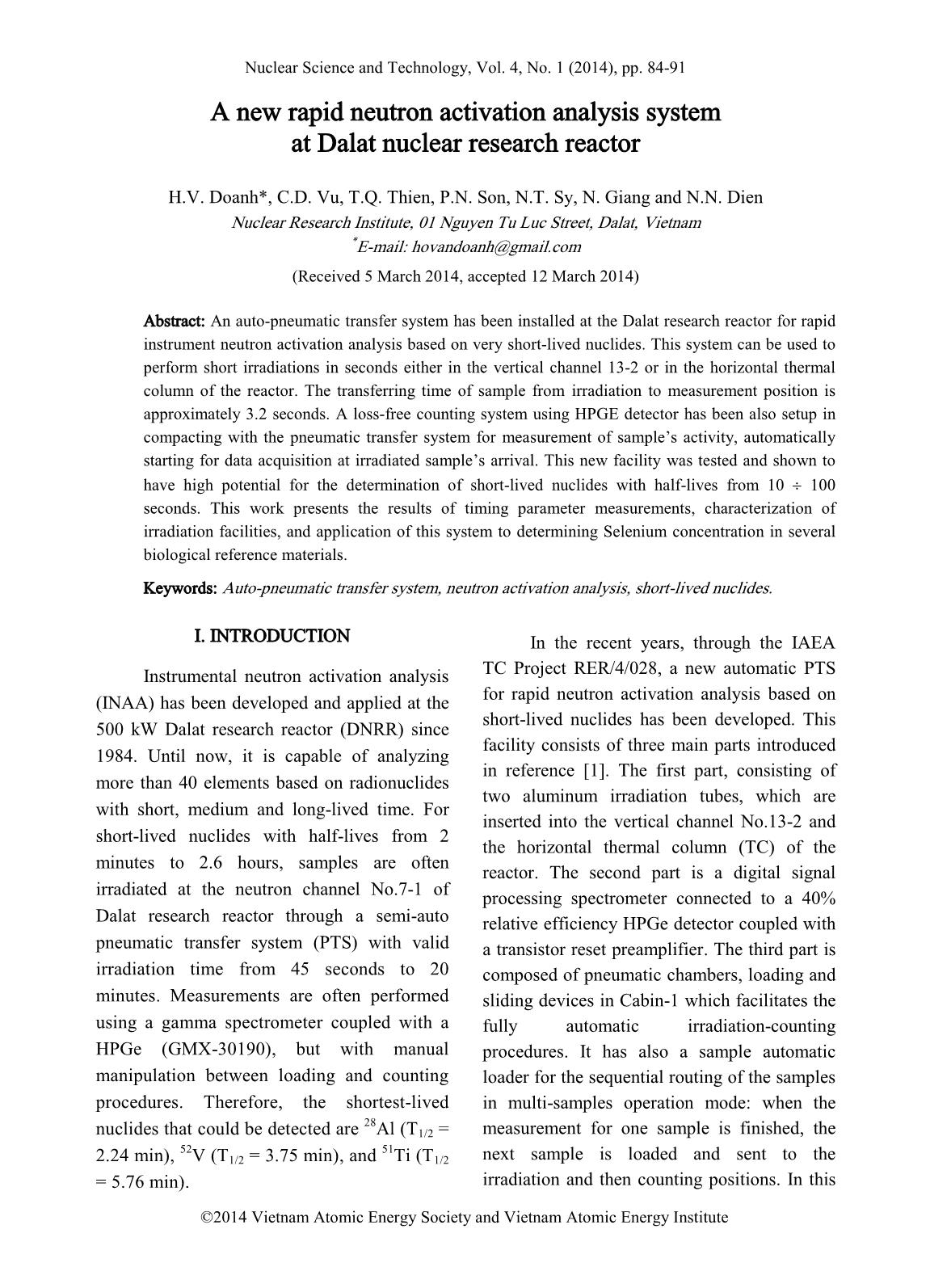
Trang 1
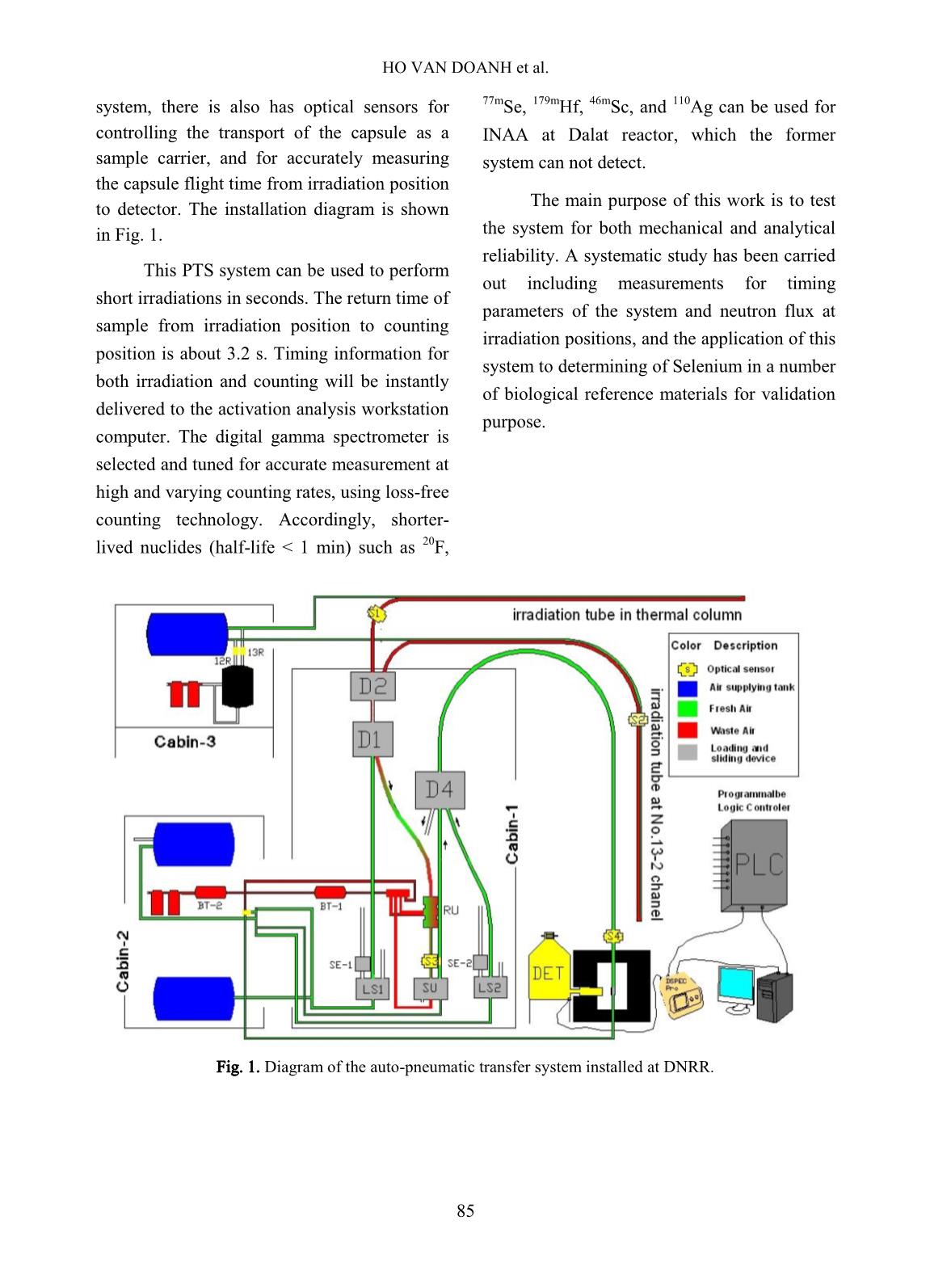
Trang 2
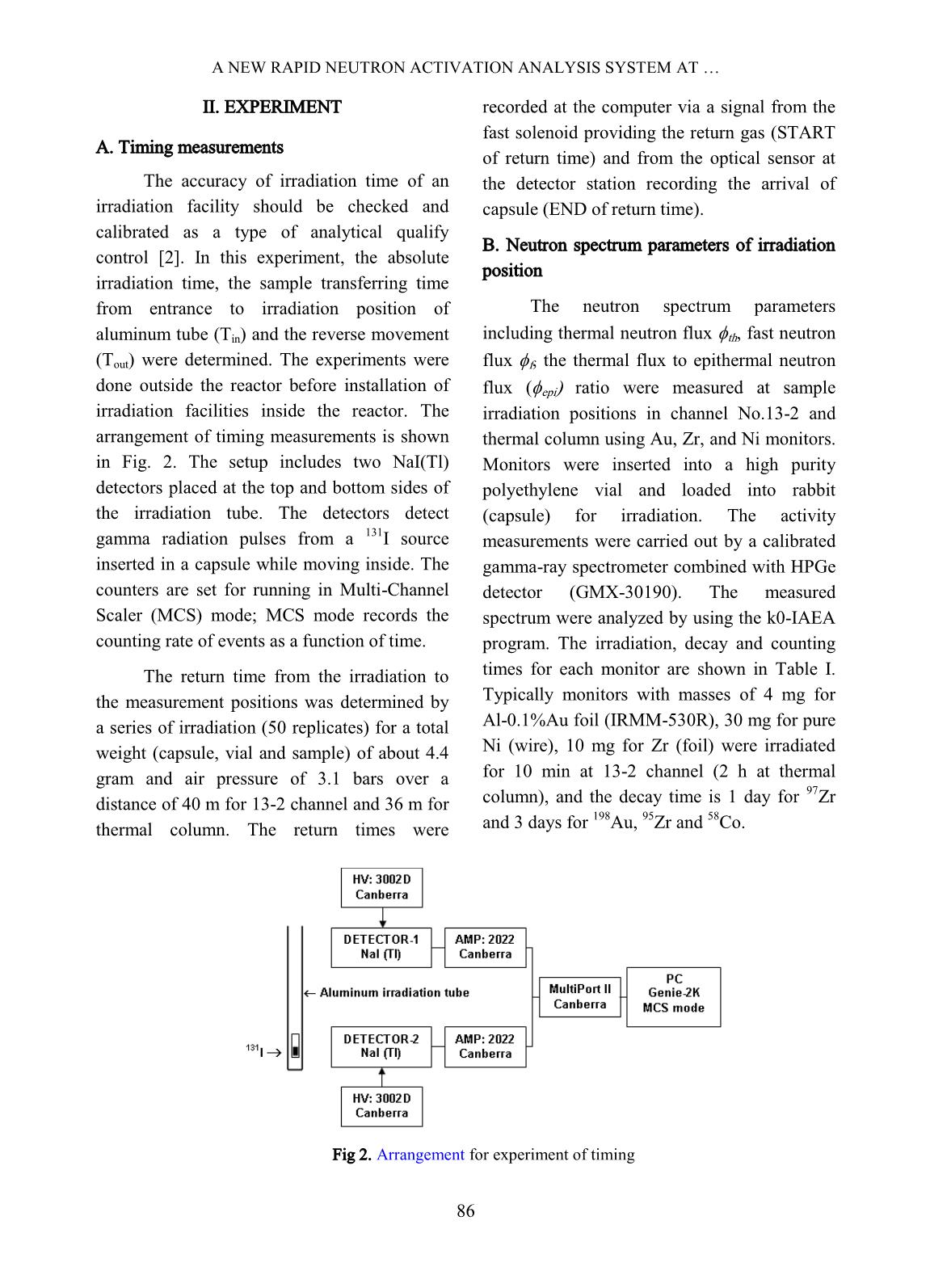
Trang 3
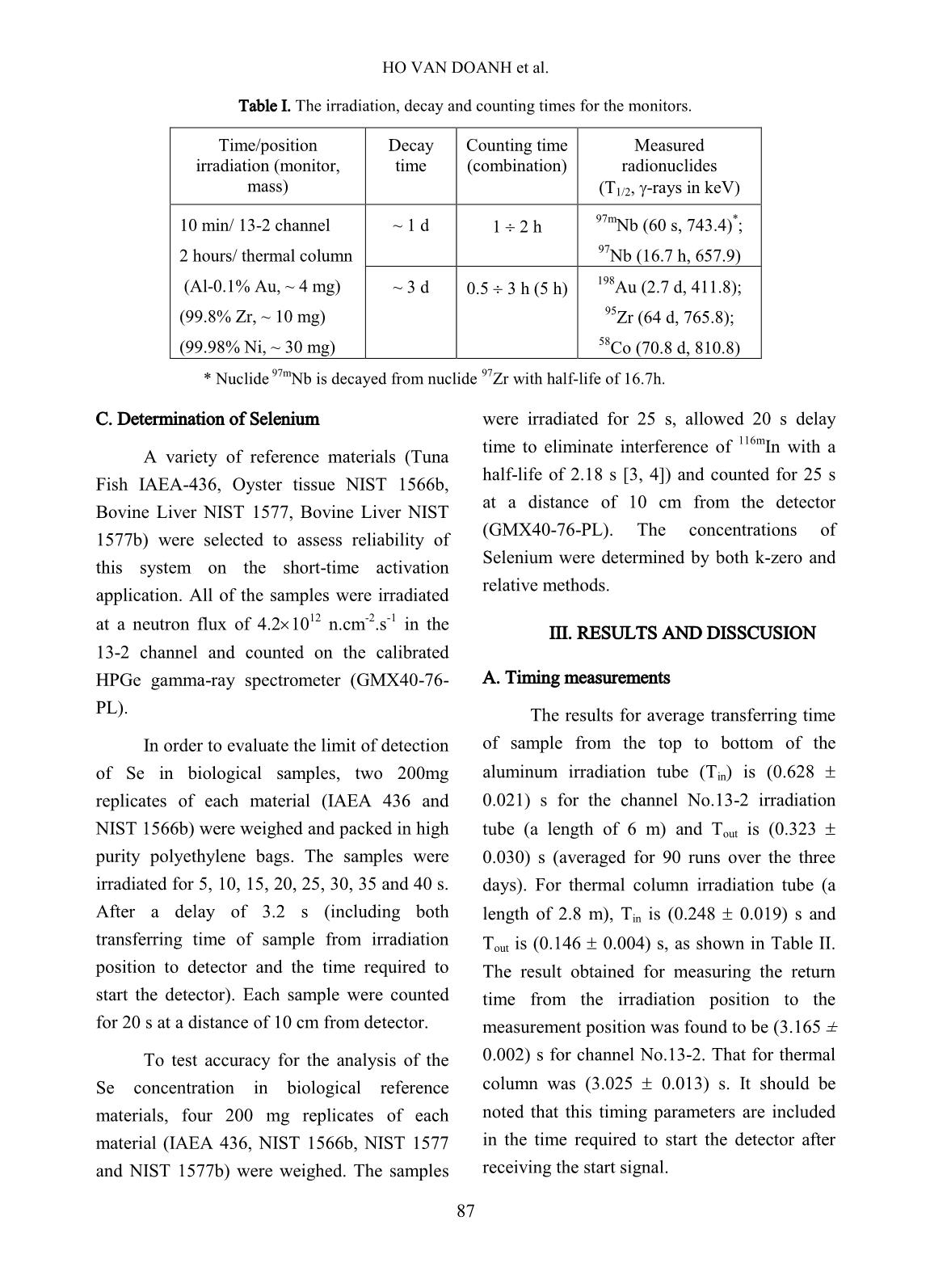
Trang 4
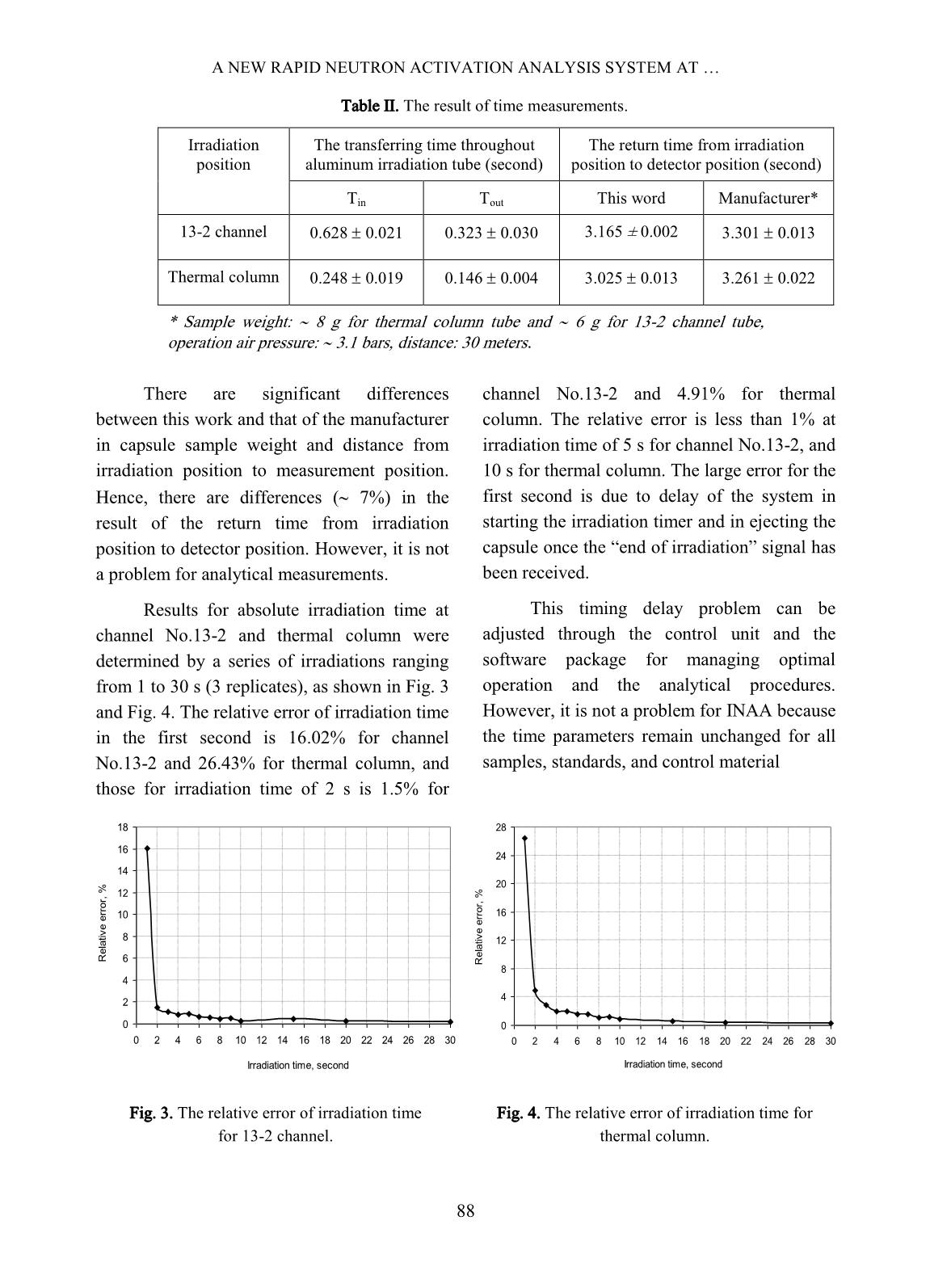
Trang 5
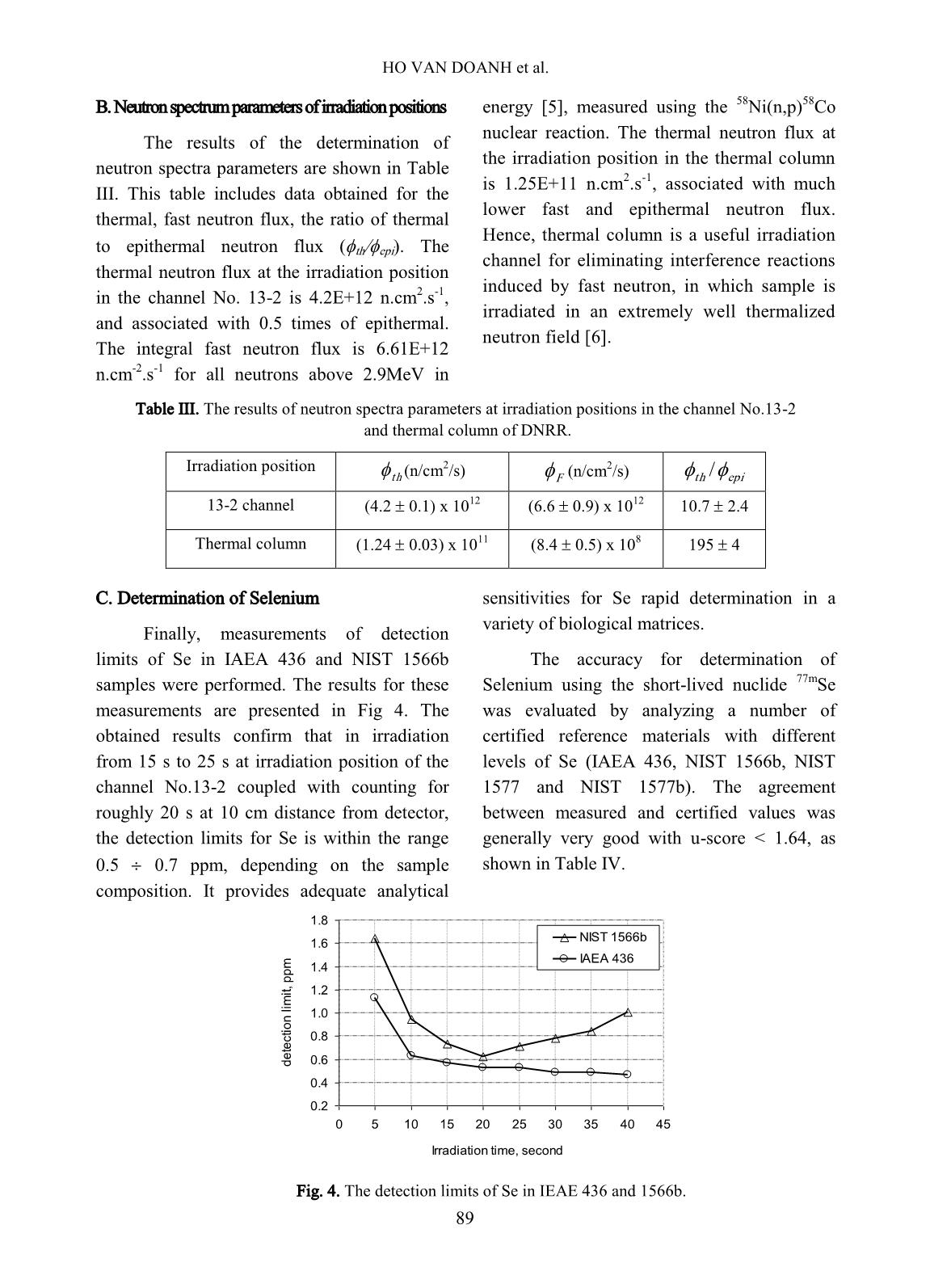
Trang 6
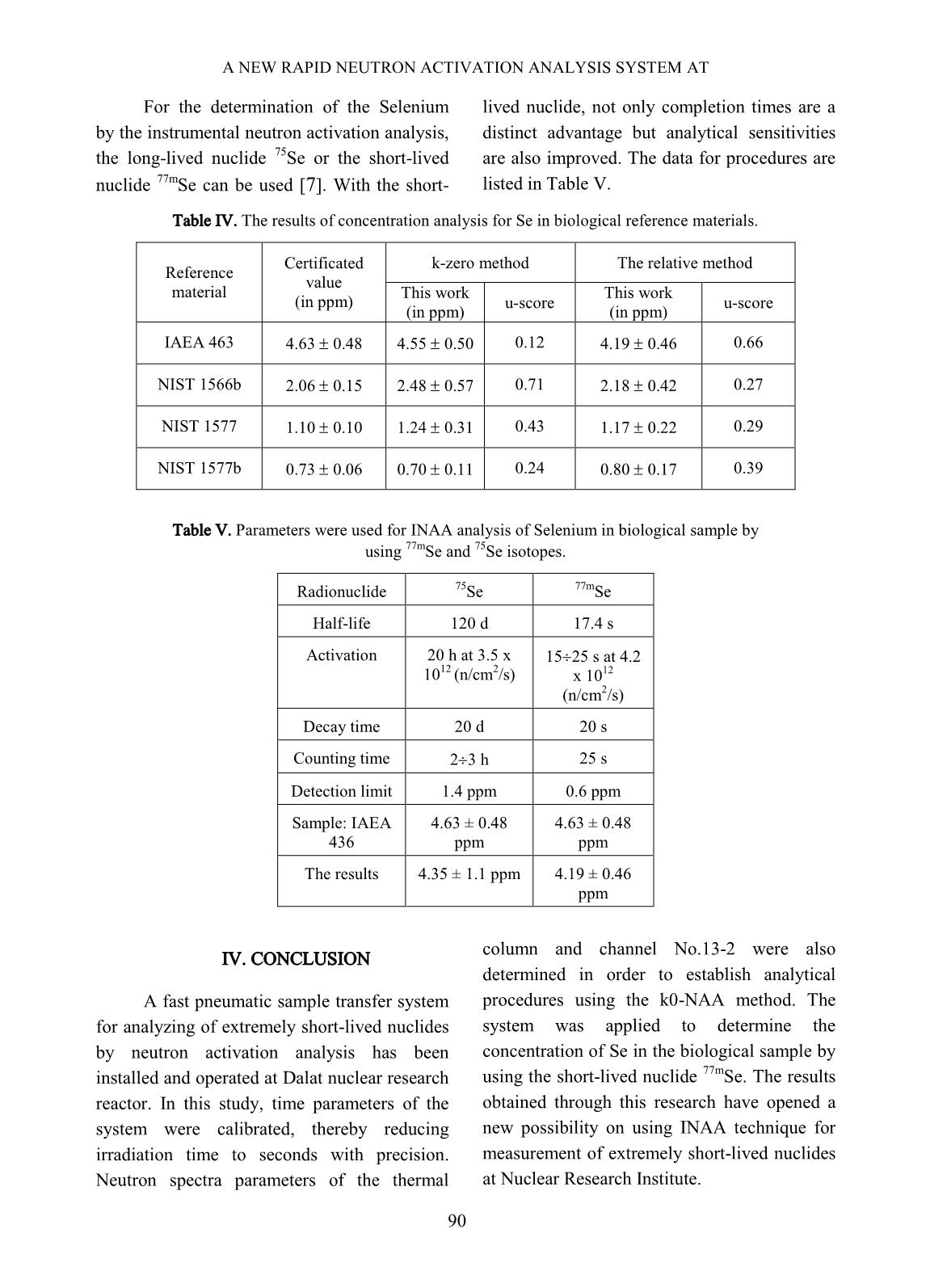
Trang 7

Trang 8
Tóm tắt nội dung tài liệu: A new rapid neutron activation analysis system at Dalat nuclear research reactor
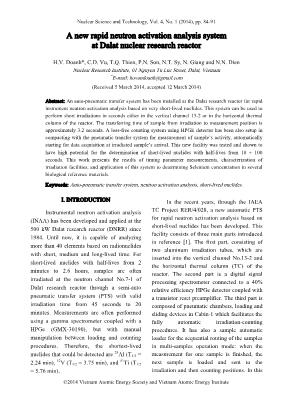
ology. Accordingly, shorter- lived nuclides (half-life < 1 min) such as 20 F, 77m Se, 179m Hf, 46m Sc, and 110 Ag can be used for INAA at Dalat reactor, which the former system can not detect. The main purpose of this work is to test the system for both mechanical and analytical reliability. A systematic study has been carried out including measurements for timing parameters of the system and neutron flux at irradiation positions, and the application of this system to determining of Selenium in a number of biological reference materials for validation purpose. Fig. 1. Diagram of the auto-pneumatic transfer system installed at DNRR. A NEW RAPID NEUTRON ACTIVATION ANALYSIS SYSTEM AT 86 II. EXPERIMENT A. Timing measurements The accuracy of irradiation time of an irradiation facility should be checked and calibrated as a type of analytical qualify control [2]. In this experiment, the absolute irradiation time, the sample transferring time from entrance to irradiation position of aluminum tube (Tin) and the reverse movement (Tout) were determined. The experiments were done outside the reactor before installation of irradiation facilities inside the reactor. The arrangement of timing measurements is shown in Fig. 2. The setup includes two NaI(Tl) detectors placed at the top and bottom sides of the irradiation tube. The detectors detect gamma radiation pulses from a 131 I source inserted in a capsule while moving inside. The counters are set for running in Multi-Channel Scaler (MCS) mode; MCS mode records the counting rate of events as a function of time. The return time from the irradiation to the measurement positions was determined by a series of irradiation (50 replicates) for a total weight (capsule, vial and sample) of about 4.4 gram and air pressure of 3.1 bars over a distance of 40 m for 13-2 channel and 36 m for thermal column. The return times were recorded at the computer via a signal from the fast solenoid providing the return gas (START of return time) and from the optical sensor at the detector station recording the arrival of capsule (END of return time). B. Neutron spectrum parameters of irradiation position The neutron spectrum parameters including thermal neutron flux th, fast neutron flux f, the thermal flux to epithermal neutron flux (epi) ratio were measured at sample irradiation positions in channel No.13-2 and thermal column using Au, Zr, and Ni monitors. Monitors were inserted into a high purity polyethylene vial and loaded into rabbit (capsule) for irradiation. The activity measurements were carried out by a calibrated gamma-ray spectrometer combined with HPGe detector (GMX-30190). The measured spectrum were analyzed by using the k0-IAEA program. The irradiation, decay and counting times for each monitor are shown in Table I. Typically monitors with masses of 4 mg for Al-0.1%Au foil (IRMM-530R), 30 mg for pure Ni (wire), 10 mg for Zr (foil) were irradiated for 10 min at 13-2 channel (2 h at thermal column), and the decay time is 1 day for 97 Zr and 3 days for 198 Au, 95 Zr and 58 Co. Fig 2. Arrangement for experiment of timing measurements. HO VAN DOANH et al. 87 Table I. The irradiation, decay and counting times for the monitors. Time/position irradiation (monitor, mass) Decay time Counting time (combination) Measured radionuclides (T1/2, -rays in keV) 10 min/ 13-2 channel 2 hours/ thermal column (Al-0.1% Au, ~ 4 mg) (99.8% Zr, ~ 10 mg) (99.98% Ni, ~ 30 mg) ~ 1 d 1 2 h 97m Nb (60 s, 743.4) * ; 97 Nb (16.7 h, 657.9) ~ 3 d 0.5 3 h (5 h) 198 Au (2.7 d, 411.8); 95 Zr (64 d, 765.8); 58 Co (70.8 d, 810.8) * Nuclide 97m Nb is decayed from nuclide 97 Zr with half-life of 16.7h. C. Determination of Selenium A variety of reference materials (Tuna Fish IAEA-436, Oyster tissue NIST 1566b, Bovine Liver NIST 1577, Bovine Liver NIST 1577b) were selected to assess reliability of this system on the short-time activation application. All of the samples were irradiated at a neutron flux of 4.2 1012 n.cm-2.s-1 in the 13-2 channel and counted on the calibrated HPGe gamma-ray spectrometer (GMX40-76- PL). In order to evaluate the limit of detection of Se in biological samples, two 200mg replicates of each material (IAEA 436 and NIST 1566b) were weighed and packed in high purity polyethylene bags. The samples were irradiated for 5, 10, 15, 20, 25, 30, 35 and 40 s. After a delay of 3.2 s (including both transferring time of sample from irradiation position to detector and the time required to start the detector). Each sample were counted for 20 s at a distance of 10 cm from detector. To test accuracy for the analysis of the Se concentration in biological reference materials, four 200 mg replicates of each material (IAEA 436, NIST 1566b, NIST 1577 and NIST 1577b) were weighed. The samples were irradiated for 25 s, allowed 20 s delay time to eliminate interference of 116m In with a half-life of 2.18 s [3, 4]) and counted for 25 s at a distance of 10 cm from the detector (GMX40-76-PL). The concentrations of Selenium were determined by both k-zero and relative methods. III. RESULTS AND DISSCUSION A. Timing measurements The results for average transferring time of sample from the top to bottom of the aluminum irradiation tube (Tin) is (0.628 0.021) s for the channel No.13-2 irradiation tube (a length of 6 m) and Tout is (0.323 0.030) s (averaged for 90 runs over the three days). For thermal column irradiation tube (a length of 2.8 m), Tin is (0.248 0.019) s and Tout is (0.146 0.004) s, as shown in Table II. The result obtained for measuring the return time from the irradiation position to the measurement position was found to be (3.165 ± 0.002) s for channel No.13-2. That for thermal column was (3.025 0.013) s. It should be noted that this timing parameters are included in the time required to start the detector after receiving the start signal. A NEW RAPID NEUTRON ACTIVATION ANALYSIS SYSTEM AT 88 Table II. The result of time measurements. Irradiation position The transferring time throughout aluminum irradiation tube (second) The return time from irradiation position to detector position (second) Tin Tout This word Manufacturer* 13-2 channel 0.628 0.021 0.323 0.030 3.165 ± 0.002 3.301 0.013 Thermal column 0.248 0.019 0.146 0.004 3.025 0.013 3.261 0.022 * Sample weight: 8 g for thermal column tube and 6 g for 13-2 channel tube, operation air pressure: 3.1 bars, distance: 30 meters. There are significant differences between this work and that of the manufacturer in capsule sample weight and distance from irradiation position to measurement position. Hence, there are differences ( 7%) in the result of the return time from irradiation position to detector position. However, it is not a problem for analytical measurements. Results for absolute irradiation time at channel No.13-2 and thermal column were determined by a series of irradiations ranging from 1 to 30 s (3 replicates), as shown in Fig. 3 and Fig. 4. The relative error of irradiation time in the first second is 16.02% for channel No.13-2 and 26.43% for thermal column, and those for irradiation time of 2 s is 1.5% for channel No.13-2 and 4.91% for thermal column. The relative error is less than 1% at irradiation time of 5 s for channel No.13-2, and 10 s for thermal column. The large error for the first second is due to delay of the system in starting the irradiation timer and in ejecting the capsule once the “end of irradiation” signal has been received. This timing delay problem can be adjusted through the control unit and the software package for managing optimal operation and the analytical procedures. However, it is not a problem for INAA because the time parameters remain unchanged for all samples, standards, and control material Fig. 3. The relative error of irradiation time for 13-2 channel. Fig. 4. The relative error of irradiation time for thermal column. 0 2 4 6 8 10 12 14 16 18 0 2 4 6 8 10 12 14 16 18 20 22 24 26 28 30 Irradiation time, second R e la ti v e e rr o r, % 0 4 8 12 16 20 24 28 0 2 4 6 8 10 12 14 16 18 20 22 24 26 28 30 Irradiation time, second R e la ti v e e rr o r, % HO VAN DOANH et al. 89 B. Neutron spectrum parameters of irradiation positions The results of the determination of neutron spectra parameters are shown in Table III. This table includes data obtained for the thermal, fast neutron flux, the ratio of thermal to epithermal neutron flux (th/epi). The thermal neutron flux at the irradiation position in the channel No. 13-2 is 4.2E+12 n.cm 2 .s -1 , and associated with 0.5 times of epithermal. The integral fast neutron flux is 6.61E+12 n.cm -2 .s -1 for all neutrons above 2.9MeV in energy [5], measured using the 58 Ni(n,p) 58 Co nuclear reaction. The thermal neutron flux at the irradiation position in the thermal column is 1.25E+11 n.cm 2 .s -1 , associated with much lower fast and epithermal neutron flux. Hence, thermal column is a useful irradiation channel for eliminating interference reactions induced by fast neutron, in which sample is irradiated in an extremely well thermalized neutron field [6]. Table III. The results of neutron spectra parameters at irradiation positions in the channel No.13-2 and thermal column of DNRR. Irradiation position th (n/cm 2 /s) F (n/cm 2 /s) epith / 13-2 channel (4.2 0.1) x 1012 (6.6 0.9) x 1012 10.7 2.4 Thermal column (1.24 0.03) x 1011 (8.4 0.5) x 108 195 4 C. Determination of Selenium Finally, measurements of detection limits of Se in IAEA 436 and NIST 1566b samples were performed. The results for these measurements are presented in Fig 4. The obtained results confirm that in irradiation from 15 s to 25 s at irradiation position of the channel No.13-2 coupled with counting for roughly 20 s at 10 cm distance from detector, the detection limits for Se is within the range 0.5 0.7 ppm, depending on the sample composition. It provides adequate analytical sensitivities for Se rapid determination in a variety of biological matrices. The accuracy for determination of Selenium using the short-lived nuclide 77m Se was evaluated by analyzing a number of certified reference materials with different levels of Se (IAEA 436, NIST 1566b, NIST 1577 and NIST 1577b). The agreement between measured and certified values was generally very good with u-score < 1.64, as shown in Table IV. 0.2 0.4 0.6 0.8 1.0 1.2 1.4 1.6 1.8 0 5 10 15 20 25 30 35 40 45 Irradiation time, second d e te c ti o n l im it , p p m NIST 1566b IAEA 436 Fig. 4. The detection limits of Se in IEAE 436 and 1566b. A NEW RAPID NEUTRON ACTIVATION ANALYSIS SYSTEM AT 90 For the determination of the Selenium by the instrumental neutron activation analysis, the long-lived nuclide 75 Se or the short-lived nuclide 77m Se can be used [7]. With the short- lived nuclide, not only completion times are a distinct advantage but analytical sensitivities are also improved. The data for procedures are listed in Table V. Table IV. The results of concentration analysis for Se in biological reference materials. Reference material Certificated value (in ppm) k-zero method The relative method This work (in ppm) u-score This work (in ppm) u-score IAEA 463 4.63 0.48 4.55 0.50 0.12 4.19 0.46 0.66 NIST 1566b 2.06 0.15 2.48 0.57 0.71 2.18 0.42 0.27 NIST 1577 1.10 0.10 1.24 0.31 0.43 1.17 0.22 0.29 NIST 1577b 0.73 0.06 0.70 0.11 0.24 0.80 0.17 0.39 Table V. Parameters were used for INAA analysis of Selenium in biological sample by using 77m Se and 75 Se isotopes. Radionuclide 75 Se 77m Se Half-life 120 d 17.4 s Activation 20 h at 3.5 x 10 12 (n/cm 2 /s) 1525 s at 4.2 x 10 12 (n/cm 2 /s) Decay time 20 d 20 s Counting time 23 h 25 s Detection limit 1.4 ppm 0.6 ppm Sample: IAEA 436 4.63 ± 0.48 ppm 4.63 ± 0.48 ppm The results 4.35 ± 1.1 ppm 4.19 ± 0.46 ppm IV. CONCLUSION A fast pneumatic sample transfer system for analyzing of extremely short-lived nuclides by neutron activation analysis has been installed and operated at Dalat nuclear research reactor. In this study, time parameters of the system were calibrated, thereby reducing irradiation time to seconds with precision. Neutron spectra parameters of the thermal column and channel No.13-2 were also determined in order to establish analytical procedures using the k0-NAA method. The system was applied to determine the concentration of Se in the biological sample by using the short-lived nuclide 77m Se. The results obtained through this research have opened a new possibility on using INAA technique for measurement of extremely short-lived nuclides at Nuclear Research Institute. HO VAN DOANH et al. 91 ACKNOWLEDGEMENTS This project was carried out under the nuclear research and development program of the Ministry of Science and Technology, Vietnam. REFERENCES [1] S.S. Ismail, A new automated sample transfer system for instrumental neutron activation analysis, journal of Automated Methods and Management in Chemistry, Vol. 2010, (2010). [2] Yong-Sam Chung, et al., Characteristics of a new pneumatic transfer system for a neutron activation analysis at the HANARO research reactor, Nuclear Engineering and Technology, Vol. 41, No. 6, p. 813 (2009) [3] U.M. El-Ghawi, et al., Determination of Selenium in Libyan Food Items Using Pseudocyclic Instrumental Neutron Activation Analysis, Biological Trace Element Research, Vol. 107, p. 61 (2004). [4] L.S. McDowell, et al., Determination of Selenium in individual food items using the short-lived nuclide 77m Se, Journal of Radioanalytical and Nuclear Chemistry, Vol. 110, No. 2, p. 519 (1987). [5] A. D. Becker, Characterization and use of the new NIST rapid pneumatic tube irradiation facility, Journal of Radioanalytical Chemistry, Vol. 233, No. 1-2, p. 155 (1998). [6] R. Gwozdz, F. Grass, J. Dorner, Fluorine analysis of standard materials by short-time activation analysis using 20 F, Journal of Radioanalytical and Nuclear Chemistry, Vol. 169, No.1, p. 57 (1993). [7] D. Behni, et al., Combination of Neutron Activation Analysis, Tracer Techniques, and Biochemical Methods in the Investigation of Selenium Metabolism, Journal of Radioanalytical and Nuclear Chemistry, p.439 (1989).
File đính kèm:
 a_new_rapid_neutron_activation_analysis_system_at_dalat_nucl.pdf
a_new_rapid_neutron_activation_analysis_system_at_dalat_nucl.pdf

